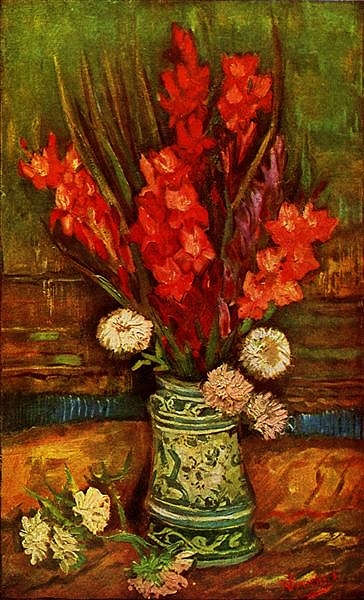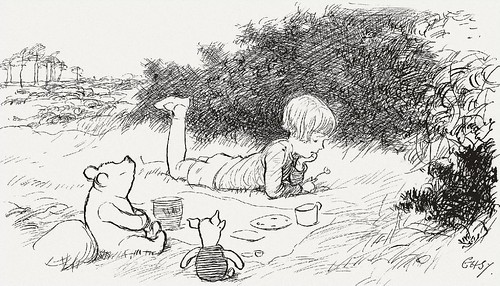If you were born in the month of August, your flower is the gladiola. It symbolizes strength of character, victory, and pride. It was named after the gladius, the sword used by Roman legions and gladiators, because of the flower’s tall stalk and the pointed petals. The gladius had a sharp pointed blade, 30 to 33 inches long, double-sided and two inches wide, and two pounds in weight. It was excellent for the close hand-to-hand combat.
“Bouquet of Gladiolas, Lilies, and Daisies” (1878) (32.5’’ x 24.5’’) is by Claude Monet. He moved with his wife and son to Vetheuil, a small village 37 miles from Paris because he could not afford to live in Paris. His flower paintings appealed to a wider audience. From 1878 until 1881, his reputation grew and his commercial success increased with the backing of Parisian art dealer George Petit, who brought Monet’s work to the attention of the Parisian art market.
The red and white gladiolas are placed with an unruly bunch of daisies to create a casual bouquet. Two white lilies center the composition. The white oriental vase and the colorful patched cloth on the table add to the rich color palette of the canvas. Monet’s choice of soft blue for the wall behind the vase and bouquet has a calming effect. Complementing the colors and shapes of the flowers and greenery, the round vase has two handles and two visible feet, and it is decorated simply with the colors in the painting.
“Vase with Red Gladiolas’’ (1886) (26’’x16’’) is by Vincent Van Gogh. Van Gogh had the opportunity in 1886 to see the fifth Exposition Internationale of works by the Impressionists. His first impression was the works were “careless, ugly, badly painted,” but by the autumn of 1886, he wrote, “I have much admired certain Impressionist pictures–Degas, nude figures–Claude Monet, landscapes.” Although the two never met, Monet’s landscape “Tulip Fields” (1886), in the Exposition, is considered to have been a strong influence on Van Gogh’s work. The intense color of the tulips, painted with a thick impasto, were very different from Van Gogh’s then current style that followed Dutch painting, with its realism and earth tones.
The colors, including those of the red gladiolas, are potent, and the brush work is vigorous. Van Gogh’s red gladiolas, symbols of the intense passion and strength of the gladiator, are powerful. In the rich green background, the two complementary colors red and green, have been used to best advantage. The green and white pattern of the vase, the pop of white flowers, the brick wall, and the rich wood tones of the table, would become the style that made Van Gogh famous.
If you were born between August 22 and September 21, your Native American Totem Animal is the bear. The bear is the guardian of the West. Bears are symbols of strength, vitality, courage, and health, to name a few. Bears are considered the ultimate protectors, and many tribes always carry the bear symbol to keep the powerful spirit of the bear with them. One example is the Zuni Bear Totem (3.35’’x 1.5’’), a fetish carved by Bernard Homer, Jr., grandson of a famous Zuni fetish carver and follower of a long tradition of carvers.
The bear carries a medicine bundle with turquoise, coral, a mussel shell arrow head. The bear has inlaid coral eyes. Turquoise, a popular stone with Native Americans and with ancient cultures around the world, brings good luck. Its bright blue color is the color of a clear sky. Coral has a long history as a symbol of the ocean. To native Americans it represents the lifeblood of Earth Mother. Coral and turquoise represent the unity of the earth and water. A valued food source, mussels live in both fresh and salt water. Mussels were a part of the sacred water world. The arrowhead represents courage and determination, important human characteristics for a successful hunt.
The bear has been a symbol in ancient cultures such as China, India, and Greece. The constellations Ursa Major and Ursa Minor, also known as the Big Dipper and the Little Dipper or the Big Bear and the Little Bear, combined are the largest constellation in the northern sky. In the Greek myth of Callisto,
Zeus, married to Hera, had a roving eye and seduced many beautiful women. When Hera discovered his relationship with the nymph Callisto, she changed Callisto into a bear made to roamed the earth and hunted for 15 years. Johann Wilhelm Baur’s etching “Callisto Hunted by Arcas” (1639) (Metamorphosis,1639) depicts the conclusion of the myth. By chance, Callisto’s son Arcas came upon her in the forest, and not recognizing her, drew his sword to kill the bear. Zeus, seeing this from above, swept down as a whirlwind and set them in the sky as the constellations Ursa Major and Minor. Callisto could watch over her son forever.
One of a bear’s most important strengths was its nurturing and protective nature. The Chippewa, Creek, Algonquian, Huron, Hopi, Cheyenne, and others tell several versions of the bear’s nurturing and supernatural healing powers. The tales tell of the bear’s mysterious power to heal itself and to teach others how to heal. Bears are considered spirit guides, and they are closely related to tribal shamans and figure in long-practiced rituals.
The cartoon by political cartoonist Clifford Berryman was first seen in the Washington Post on November 16, 1902. He was inspired by newspaper stories about President Theodore Roosevelt, a well-known big game hunter. While on a bear hunt, he could not find a bear to shoot. Some of the men with him found a young black bear and tied it up for the kill. Roosevelt refused to shoot it, to do so was unsportsmanlike. Berryman’s cartoon caught the attention of Morris Michtom, a toymaker. With the President’s approval, he started selling “Teddy Bears.” Roosevelt created the United States Forest Service, five National Parks, and conserved over 230 million acres of land.
The story of bears continued in the London Evening News in 1925, as a children’s Christmas story with writer A.A. Milne and illustrator E.H. Shepherd. Milne bought a teddy bear for his son Christopher Robin Milne for Christmas from Herod’s Department Store in London. Christopher named his bear Winnie after a Canadian black bear he saw at the London Zoo. The Canadian black bear was a gift from Canadian Lieutenant Harry Colebourn, who purchased the cub while in Canada on his way to England during the First World War. He named the bear ‘Winnie” after his adopted hometown of Winnipeg. Winnie, a female bear, was a popular attraction. Pooh was the name of Christoper’s friend’s swan. Winnie the Pooh was drawn by Ernest Howard Shepherd, an illustrator at Punch Magazine. His drawing was inspired by his son’s teddy bear named Growler. The book Winnie-the-Pooh was first published in 1926.
The book A Bear Called Paddington first appeared on October 13, 1958. The book was written by British author Michael Bond and illustrated by Peggy Fortnum. Bond was inspired by a solitary teddy bear on a shelf in a bookstore near Paddington Station on Christmas Eve1956. He bought it for his wife. The inspiration for the story came during his observation of Jewish refugee children and London children who were sent to the country for safety during World War II. The children wore signs saying “Please look after this child.” Bond wrote the first story in ten days. Peggy Fortnum was commissioned to make black and white drawings for the book.
Peggy Fortnum, born in north London in1919, always wanted to be an artist, and she enrolled in art school in 1939. However, she could not stay out of the War after witnessing the bombing of London in 1940. She was a member of ATS, the women’s branch of the British Army. After a long recovery from a war injury, she returned to art school and went on to became an art teacher, painter, textile designer, and book illustrator. To be as accurate as possible, she went to the London Zoo and sketched and photographed Malayan black bears. “At the beginning, I wasn’t sure of the anatomy,” she wrote. “I wasn’t sure what to do with his paws…It takes an age to get it right.” Bond said of Fortnum, “She thought very highly of Paddington, as I did of her. It was a happy combination.”
In 1942, a Japanese submarine attacked a southern California oil field next to the Los Padres National Forest. The War Advertising Council created a campaign to warn of the dangers of forest fires. On August 9, 1944, Smokey the Bear became the mascot of the U.S. Forest Service. He was drawn by the then popular animal illustrator Albert Staehle, and named after Smokey Joe Ryan, a famous New York City Fire Chief. After a discussion about Smokey’s image needing to be family and child friendly, officials selected the image of gentle bear holding a can of water and putting out a fire. Staehle designed the next two Smokey posters. During his career he drew 25 Saturday Evening Post covers, illustrated for the American Weekly, and created popular animal logos for products. Billboards using his popular animal images could be seen all over America.
Just one more bear story. In the spring of 1950, a fire in the Capitan Mountains of New Mexico left a badly burned bear cub clinging to a tree. Firefighters found him and named him Smokey. Smokey was given a home at the National Zoo in Washington, DC, and he became a popular resident and a national symbol of conservation and fire safety. When he died in 1976, his remains were taken back to Capitan, New Mexico, and buried in the State Historical Park.
Beverly Hall Smith was a professor of art history for 40 years. Since retiring with her husband Kurt to Chestertown in 2014, she has taught art history classes at WC-ALL. She is also an artist whose work is sometimes in exhibitions at Chestertown RiverArts and she paints sets for the Garfield Center for the Arts.











Write a Letter to the Editor on this Article
We encourage readers to offer their point of view on this article by submitting the following form. Editing is sometimes necessary and is done at the discretion of the editorial staff.